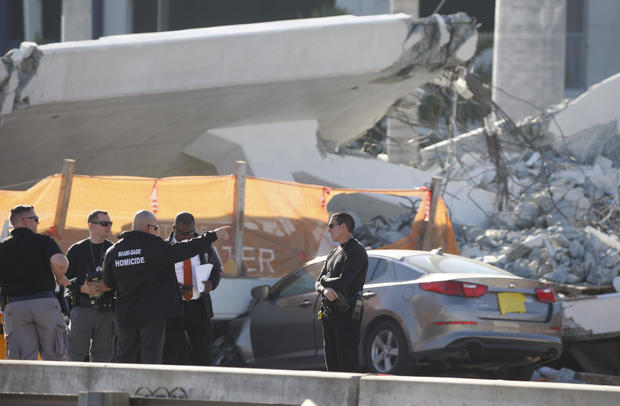MIAMI — Authorities said Friday that cables supporting a pedestrian bridge under construction in Florida were being tightened following a “stress test” when the 950-ton concrete span collapsed over traffic, killing at least six people, injuring 10 others and flattening an untold number of cars. Officials expected to find more bodies in the rubble. People who haven’t heard from their loved ones congregated near the scene Friday.
Jorge and Carol Fraga drove from West Palm Beach, fearing their relative’s car was trapped beneath the bridge at Florida International University. Sixty-year-old Rolando Fraga, Jorge’s uncle, lives in the area and frequently takes the nearby turnpike to work, but no one has heard from him since mid-day Thursday.
“The waiting is so … I don’t have words for that,” Carol Fraga said through tears.
The $14.2 million project was supposed to be a hallmark of the faster, cheaper and less risky method of bridge-building promoted by the university. Slated to open in 2019, it would have provided safe passage over a canal and six lanes of traffic, and created a showpiece architectural feature connecting the FIU campus and the community of Sweetwater, where many students live.
Munilla Construction Management (MCM) — a federal military contractor for the U.S. Army and Navy — partnered with the FIGG Bridge Group to complete the bridge. FIGG has contracts with the Kennedy Space Center and NASA.
Earlier this month, MCM was sued in South Florida by a TSA employee who was hurt at the Fort Lauderdale airport. The employee’s lawyer alleges that a makeshift bridge MCM built for workers to use while the company does construction at the airport broke under his weight.
As for FIGG, a 90-ton portion of a bridge the company was assembling in Virginia in June 2012 fell apart while under construction. The Virginian Pilot reports four workers were hurt and that state regulators fined FIGG $28,000 for safety violations saying it was “pure luck no one was killed.”
Both companies expressed condolences for the victims and promised cooperation. As state and federal investigators worked to determine why the five-day-old span failed, Florida politicians pointed to the stress test and loosened cables as possible factors, and a police chief asked everyone not to jump to conclusions.
“This is a tragedy that we don’t want to re-occur anywhere in the United States,” said Juan Perez, director of the Miami-Dade police. “We just want to find out what caused this collapse to occur and people to die.”
On Twitter, Miami-Dade Police asked people to contact the homicide bureau with any information about a cause.
A Florida International University student was among the fatalities, and several construction workers were among the 10 people injured. One person died at a hospital, and Perez said five bodies were located with the help of cameras but not yet retrieved from vehicles crushed under the immense slab. No identities have been released.
“We’re not even going to talk numbers anymore because we expect to find other individuals down there,” Perez said.
Experts from the National Transportation Safety Board and the Occupational Safety and Health Administration joined police in taking over command of the scene Friday from first responders, who had spent hours racing to find survivors in the rubble of the 175-foot span using high-tech listening devices, trained sniffing dogs and search cameras.
Florida Gov. Rick Scott said Thursday investigators will get to the bottom of “why this happened and what happened,” and if anyone did anything wrong, “we will hold them accountable.”
Sen. Marco Rubio, who is an adjunct professor at the school, noted the pedestrian bridge was intended to be an innovative and “one-of-a-kind engineering design.”

Police work next to a crushed car under a section of a collapsed pedestrian bridge, Friday, March 16, 2018 near Florida International University in the Miami area.
Wilfredo Lee / AP
When finished, the bridge would have been supported from above, with a tall, off-center tower and cables attached to the walkway. That tower had not yet been installed, and it was unclear what builders were using as temporary supports.
Andy Herman, a bridge engineer and former president of the American Society of Civil Engineers, told The Associated Press that its so-called “accelerated bridge construction” has been used for years without problems.
He said municipalities like this method because it allows for building a bridge faster “because you’re doing a lot of the work in a centralized location where you don’t have to worry about being over traffic and then they drive it or lift it into place over the traffic with minimal downtime – so the advantage is that they can build it faster with less disruption to traffic.”
The school has long been interested in this kind of bridge design; in 2010, it opened an Accelerated Bridge Construction Center to “provide the transportation industry with the tools needed to effectively and economically utilize the principles of ABC to enhance mobility and safety, and produce safe, environmentally friendly, long-lasting bridges,” according to the university website.

